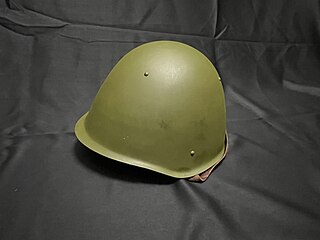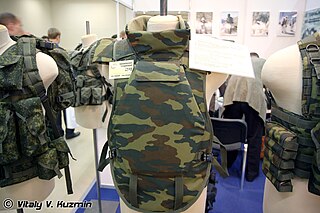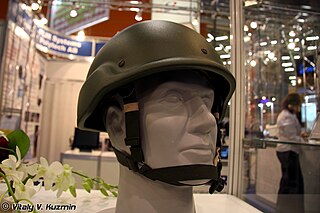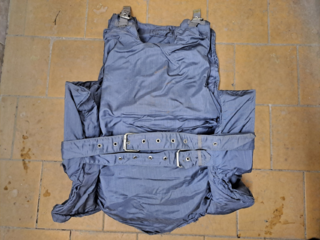Related Research Articles

Kevlar (para-aramid) is a strong, heat-resistant synthetic fiber, related to other aramids such as Nomex and Technora. Developed by Stephanie Kwolek at DuPont in 1965, the high-strength material was first used commercially in the early 1970s as a replacement for steel in racing tires. It is typically spun into ropes or fabric sheets that can be used as such, or as an ingredient in composite material components.

A bulletproof vest, also known as a ballistic vest or bullet-resistant vest, is a type of body armour designed to absorb impact and prevent the penetration of firearm projectiles and explosion fragments to the torso. The vest can be either soft—as worn by police officers, security personnel, prison guards, and occasionally private citizens to protect against stabbing attacks or light projectiles—or hard, incorporating metallic or para-aramid components. Soldiers and police tactical units typically wear hard armour, either alone or combined with soft armour, to protect against rifle ammunition or fragmentation. Additional protection includes trauma plates for blunt force and ceramic inserts for high-caliber rounds. Bulletproof vests have evolved over centuries, from early designs like those made for knights and military leaders to modern-day versions. Early ballistic protection used materials like cotton and silk, while contemporary vests employ advanced fibers and ceramic plates. Ongoing research focuses on improving materials and effectiveness against emerging threats.

Nomex is a trademarked term for an inherently flame-resistant fabric with meta-aramid chemistry widely used for industrial applications and fire protection equipment. It was developed in the early 1960s by DuPont and first marketed in 1967.

Body armor, personal armor, armored suit (armoured) or coat of armor, among others, is armor for a person's body: protective clothing or close-fitting hands-free shields designed to absorb or deflect physical attacks. Historically used to protect military personnel, today it is also used by various types of police, private security guards, or bodyguards, and occasionally ordinary citizens. Today there are two main types: regular non-plated body armor for moderate to substantial protection, and hard-plate reinforced body armor for maximum protection, such as used by combatants.

The hełm wz. 31 was the basic combat helmet of the Polish Army before the outbreak of World War II and during the Invasion of Poland. The helmet became the basic type of combat headgear for Polish military formations in the 1930s and during the early stages of World War II. It was also exported to Persia, Albania and Republican Spain. By September 1939 approximately 320,000 helmets were delivered to the Polish Army.

The Enhanced Combat Helmet (ECH) is a combat helmet designed in conjunction of a joint program of the United States Marine Corps and United States Army to replace the current combat helmets in use by the U.S. Army, Marines, Navy, and Air Force. Although similar in shape of the Advanced Combat Helmet and its predecessor the Modular Integrated Communications Helmet, the ECH is instead constructed using thermoplastics instead of the ballistic fibers used on previous-generation combat helmets.

The Sfera, officially called STSh-81, are bullet-resistant combat helmets of titanium and steel manufactured with protective GOST rating of 2. They are worn by the Internal Troops of the Interior Ministry in the Soviet Union and its successor state Russia. These helmets continue to be used today by the police and special purpose troops.

The SSh-68 - is a steel combat helmet of the Soviet and then Russian Armed Forces. The SSh-68 is a further development of the SSh-60 helmet. It differs primarily in its greater strength, greater front slope of the dome and the shorter outer edge. It is usually painted in dark green.

Ratnik is a Russian future infantry combat system. Some components, including the communication systems and night vision technologies, have extremely limited military distribution. It is designed to improve the connectivity and combat effectiveness of combat personnel in the Russian Armed Forces. Improvements include modernised body armour, a helmet with a special eye monitor, communication systems, and special headphones. It includes 10 subsystems and 59 individual items.
AuTx is a terpolyaramide fibre that was developed from 2005 to 2012 by Alchemie Group. The brand name was created by Haslen Back that led the team with the assistance of Kamenskvolokno https://www.kvolokno.ru/ and Dr Igor Tikhanov at NPO Termotex. It is based on Russian aramid 29.4tex fibre that was modified under program with the US DoD, PEO Soldier led by Dr James Zheng to lighten the weight of the IOTV body armour vest. By 2012 the fragmentation resistant panels made from AuTx were 27% lighter than from Kevlar. A terpolyaramide fibre at 60Tex is now made in the USA by DuPont and sold under the Kevlar EXO brand.
The BK-3 is a Croatian Combat helmet produced by Šestan-Busch, and is the standard combat helmet of the Croatian Armed Forces. It is also widely exported to many NATO and Middle Eastern customers.

The GK80 is a Chinese steel combat helmet first developed in the late 1960s. Developed as part of a Chinese military aid to Albania in response to the Sino-Soviet split, the helmet was initially designated as the "Type 69" and was only issued in small numbers within the People's Liberation Army. An improved design was re-designated as the GK80 and was adopted as the standard combat helmet of the PLA in 1980. The move was part of a PLA modernization program immediately after encountering drawbacks in the Sino-Vietnamese War in 1979, which the PLA realized the necessity to modernize its arsenal.

6B2 is a Soviet ballistic vest. It is the first serial mass issued body armor of the Soviet Armed Forces, designed on the eve of Soviet-Afghan war. It was introduced into service in 1981. Use of this vest decreased losses of Soviet troops and it became the basis for the further development of domestic personal protective equipment.

6B3 is a ballistic vest of the Soviet Armed Forces. It was the first widely issued and mass produced ballistic vest rated to stop assault rifle rounds. It was created by NII Stali after Soviet troops in Afghanistan noted the lack of protection against rifle rounds that the 6B2 ballistic vest provided.

6B5, is a bulletproof vest family created for the Soviet Armed Forces by NII Stali. The 6B5 was designed as a replacement for previous 6B3 and 6B4 body armour.

"Zabralo" is a series of ballistic vests created for the Russian Armed Forces under the supervision of GRAU for inclusion in the basic set of personal equipment "Barmitsa". They were intended as a replacement for the Soviet ballistic vests 6B3, 6B4 and 6B5. The Zabralo armors was a major advance for Russian armor development due to its design.

6B7 is a ballistic helmet of the Russian Armed Forces. Being the first aramid helmet in the Russian army, it was fielded as a replacement of SSh-68 helmet. It was adopted in the year 2000 as part of Borit-M program.

6B47 is a standard ballistic helmet of the Armed Forces of the Russian Federation. Developed by Armokom, it is a part of the Ratnik infantry combat system.
Altyn is a titanium helmet developed in the Soviet Union and adopted by the KGB. Providing great protection to the wearer and equipped with an armored visor, it became popular with Russian Internal affairs and security services Spetsnaz units. These helmets are made by NII Stali.

ZhZT-71 was a Soviet ballistic vest created for the MVD. It was a first ballistic vest designed for law enforcement. Design decisions made during development of its modification, ZhZT-71M, were later used in designing of 6B2 ballistic vest.
References
- 1 2 3 4 "6Б6 Титановый армейский шлем России | ОБЗОР ШЛЕМА". Youtube.
- 1 2 СРЕДСТВА ИНДИВИДУАЛЬНОЙ БРОНЕЗАЩИТЫ (РУКОВОДСТВО СЛУЖБЫ). Moscow: Братишка. 2004. pp. 22–24. ISBN 5-902104-02-5.